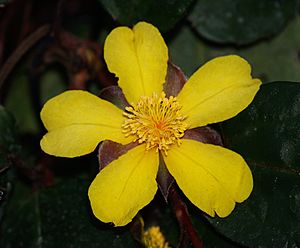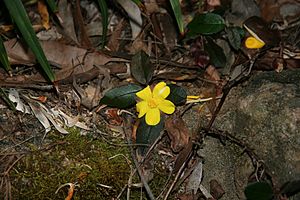Toothed guinea flower facts for kids
Quick facts for kids Toothed guinea flower |
|
|---|---|
 |
|
| Scientific classification | |
| Genus: |
Hibbertia
|
| Species: |
dentata
|
The Hibbertia dentata, also known as the toothed guinea flower, trailing guinea flower, or twining guinea flower, is a beautiful plant. It is a type of ornamental plant from the Dilleniaceae family. This plant naturally grows along the east coast of Australia.
You can find it in woodlands, where it grows as a vine that trails or twines around other plants. Its leaves have small 'teeth' on their edges, and it produces bright yellow flowers in early spring. This plant is easy to grow and can even be kept in a pot. Scientists first described this species in 1817.
Contents
What's in a Name?
The Hibbertia dentata was first officially described in 1817. This happened in a book called Regni Vegetabilis Systema Naturale. The botanist Robert Brown helped describe it, and it was published by Augustin Pyramus de Candolle.
The second part of its name, dentata, comes from a Latin word meaning "toothed". This name was chosen because the plant's leaves have small teeth along their edges.
How to Spot It: Description
The Hibbertia dentata grows as a vine that twines or wraps around things. Its stems can grow quite long, up to 2 to 3 meters (about 6.5 to 10 feet). They often trail over rocks or other shrubs.
The leaves are dark green and shaped like an oval. They are about 4 to 7 centimeters (1.5 to 2.7 inches) long and 1.5 to 3 centimeters (0.6 to 1.2 inches) wide. Each leaf sits on a short stem about 1 centimeter (0.4 inches) long. The tip of the leaf can be pointy or rounded. The edges of the leaves have small teeth, which is why it's called "toothed guinea flower." When they are young, the leaves might have a purple tint and feel fuzzy. As they get older, they become smooth.
The bright yellow flowers mostly appear from July to November. They grow from the leaf joints or at the ends of short stems. Each flower has five petals, which are about 2 to 3 centimeters (0.8 to 1.2 inches) long. They also have more than 30 stamens, which are the parts that produce pollen. These flowers usually only last for a day or two before they wilt. The fruit ripens from November to January. When ready, it splits open to release the seeds.
Where It Lives: Distribution and Habitat
You can find Hibbertia dentata in open forests or at the edge of rainforests. It grows along the east coast and inland areas of New South Wales. It also stretches into southeastern Queensland and eastern Victoria.
In the Sydney area, it often grows near trees like mountain grey gum (Eucalyptus cypellocarpa), Sydney peppermint (E. piperita), messmate (E. obliqua), Sydney red gum (Angophora costata), and turpentine (Syncarpia glomulifera). It also grows with scrub plants like coastal tea tree (Leptospermum laevigatum).
This plant prefers sheltered slopes where the soil drains well. It can grow in soils made of clay, shale, or sandstone that have a lot of nutrients.
How It Survives: Ecology
The Hibbertia dentata is quite tough. After a bushfire, it can grow back from its roots. It can even flower again within ten months after a fire. New seedlings have also been seen growing in the same amount of time.
The flowers are popular with different insects. European honeybees visit them, as do native short-tongue bees from the Halictidae and Colletidae families. Large hoverflies from the Melangyna group also like to visit the flowers.
Growing Your Own: Cultivation
Even though you don't see it in many gardens, Hibbertia dentata is an easy plant to grow. It can handle more shade than the more common H. scandens. It needs good drainage, but it's important to keep the soil moist. The plant will suffer if it dries out too much. It also grows very well in a pot.
This plant was first grown in gardens in England in 1814. In 1817, a gardening magazine called The Botanical Cabinet said it was "a fine subject for planting out in a conservatory."
It's quite easy to grow new plants from cuttings taken from a mature plant. Sometimes, new seedlings will even pop up on their own in gardens where the plant is already growing.


